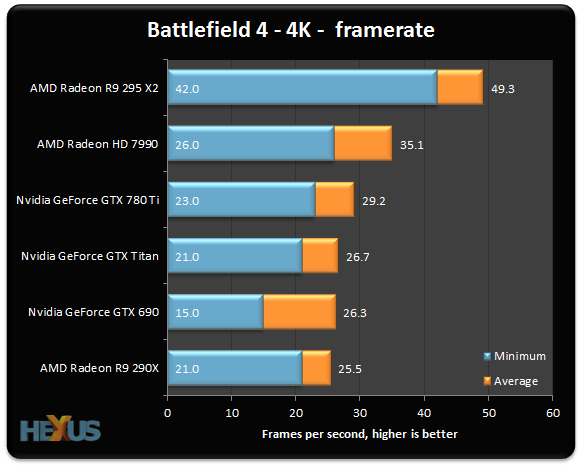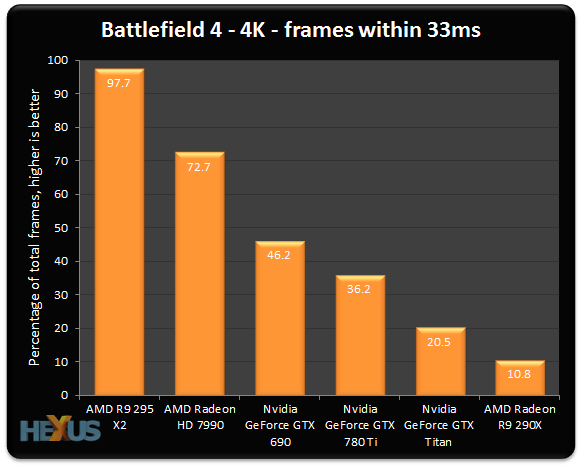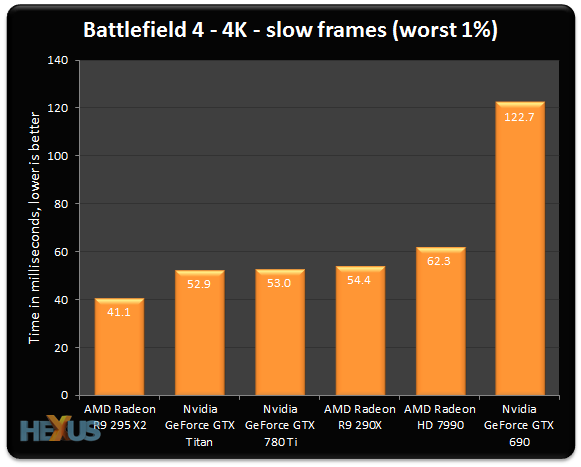Battlefield 4
 |
Homepage: battlefield.com/uk/battlefield-4 | Publisher: Electronic Arts | Developer: EA Digital Illusions |
A game that needs no introduction, Battlefield 4 is the latest incarnation of DICE's epic first-person shooter.

Remember, we're testing at a 4K resolution that's made all the more difficult by running ultra-quality image settings. The game really can't look much better than this.
Such a load really, really pushes single-GPU cards, so much so that not even the excellent GeForce GTX 780 Ti can break the 30fps average framerate barrier. The X2's scaling is excellent here, almost perfect, with an extra 93.3 per cent performance available over a single R9 290X.
Average and minimum framerates tell you a reasonable amount about a card's ability, granted, but looking with more granularity requires that we analyse how each card is spitting out the frames. Dual-GPU cards have, in the past, posted appealing average framerates, only to be compromised by a substandard experience - games have oftentimes felt choppy even though FRAPS has reported in excess of 30fps for the run(s).
The first thing we can do is to see what percentage of total frames are rendered within 33ms at the 4K resolution and eye-popping image quality levels. In an ideal world you'd want every frame to be under 33ms, which equates to at least 30fps when judged over a full second.

Extrapolating the data shows that dual-GPUs also produce the most sub-33ms frames. The X2 is almost perfect in this regard, while the single-GPU 290X simply doesn't have the silicon artillery to stay in the sub-33ms club for long.
But having a large proportion of frames rendered in under 33ms, while nice and good, still doesn't tell the full story. You don't readily perceive the good frames - smoothness is almost implied - but slow frames, rendered anywhere during the benchmark run, are immediately obvious.
We can also extrapolate data and determine how slow the worst 1 per cent of frames are. You'd want the worst frames to be quite close to the average, intimating smooth gameplay, yet this is often not the case with dual-GPU cards.

A couple of points to note here. The two other dual-GPU cards suffer when viewed from this angle. The worst 1 per cent of frames are rendered in more than 62.3ms (equates to 16 fps over a full second, if they lasted that long) for the HD 7990 and in a horrible 122.7ms (8.1fps) for the GTX 690. These are undesirable numbers that have predicated our belief you are better off with a single-GPU card that, usually, exhibits far more consistent behaviour. These slow frames really are felt when gaming.
The GTX 690 likely fares so badly because it is hamstrung by a 2GB-per-GPU framebuffer, which causes havoc when meting our frames at 4K. The monster Radeon R9 295X2, meanwhile, with massive internal horsepower, XDMA interface and 4GB per GPU, has no such problems. It is the fastest and smoothest card here, evaluated from any angle we wish.









